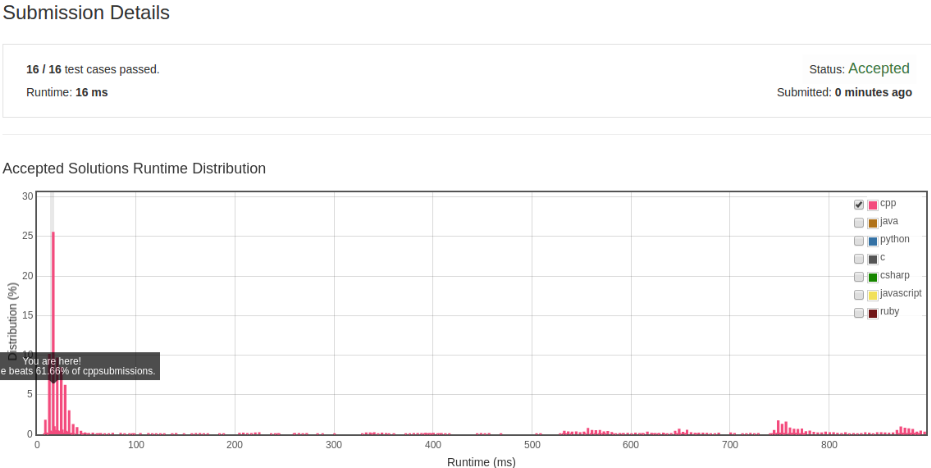凌云的博客
行胜于言
LeetCode 算法题 1. 两数之和
分类:algorithm| 发布时间:2016-06-23 12:40:00
题目
给定一个整数数组 nums 和一个目标值 target,请你在该数组中找出和为目标值的那 两个 整数,并返回他们的数组下标。
你可以假设每种输入只会对应一个答案。但是,你不能重复利用这个数组中同样的元素。
示例:
给定 nums = [2, 7, 11, 15], target = 9,
因为 nums[0] + nums[1] = 2 + 7 = 9,
所以返回 [0, 1].
思路
首先想到就是通过哈希表(hash_table)来记录需要的数值与下标的对应关系。 按顺序扫描数组,查找 hash_table 中有没有 key 等于当前数值(cur_val)的情况, 如果有则是找到了解,返回 hash_table 记录的下标以及当前下标。 否则将 target - cur_val 以及 当前下标的关系记录到 hash_table 中。
C++ 算法实现
class Solution {
public:
vector<int> twoSum(vector<int>& nums, int target) {
unordered_map<int, int> m;
const int size = nums.size();
int tmp;
for (int i = 0; i != size; ++i) {
tmp = nums[i];
if (m.find(tmp) != m.end()) {
return {m[tmp], i};
}
m[target - tmp] = i;
}
return {-1, -1};
}
};

更快的算法
在讨论区看到有耗时 8ms 的算法,比哈希方案快了一倍。 基本思路是扫描一遍给出的数组,找出有可能符合条件的数字的最大和最小值,创建一个数组来记录数值与下标的对应关系, 再扫描一遍给定的数组,找出合适的解。
class Solution {
public:
vector<int> twoSum(vector<int>& nums, int target) {
// Since x1 + x2 = target, we can in one loop
// mark both x1 and x2 in some additional array where we'll keep indices
// Though to build that array we'd need another loop
int min = nums[0], max = min;
// first loop to find max and min integers
for (int i = 0;i < nums.size();i++) {
if (nums[i] < min) min = nums[i];
if (nums[i] > max) max = nums[i];
}
// valid range for input integers relative to target
int sMin;
int sMax;
if(min < target - max) {
sMin = min;
} else {
sMin = target - max;
}
if(max > target - min) {
sMax = max;
} else {
sMax = target - min;
}
// array to keep indices of valid input integers
// initialize with -1
int size = 1 + sMax - sMin;
int arr[size];
// for (int i = 0; i < arr.length;i++)
// arr[i] = -1;
fill(arr,arr+size,-1);
// second loop
int offset = -sMin;
for (int i = 0;i < nums.size();i++) {
// Skip if integer is not from a valid range
if (nums[i] > sMax || nums[i] < sMin) continue;
// if found valid X1 and corresponding element of indices array is still -1
// then mark its pair X2 = target - X1 in indices array
if (arr[nums[i] + offset] == -1) {
arr[target-nums[i] + offset] = i;
} else {
return {arr[nums[i] + offset],i};
}
}
return {0,0};
}
};
这种解法相对哈希表来说,主要利用了数组寻址快的特性。 但需要注意的是在某些情况下(sMax 和 sMin 相差过大)会导致生成的临时数组过大, 耗用大量内存,同时这种情况下也将耗费大量时间初始化这个数组。 不过 LeetCode 给出的 testcase 明显没有测试这种情况。
2019年11月更新,由于 LeetCode 更新了 testcase ,这个算法已经不适用,如:[50000000,3,2,4,50000000]